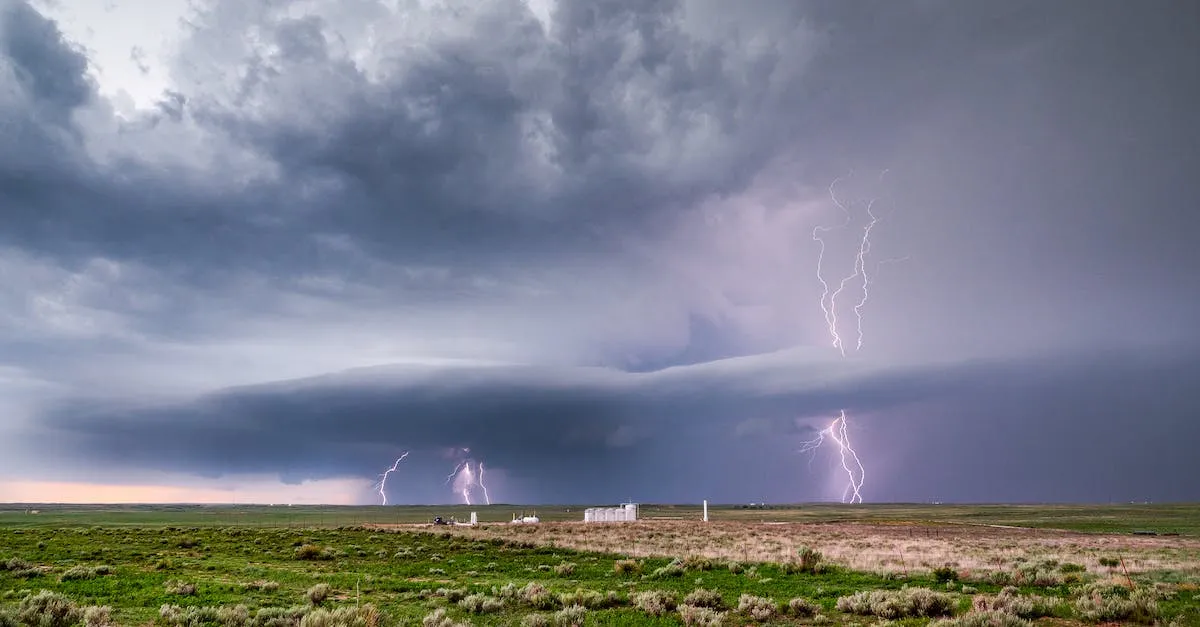Why Is Texas Weather So Weird?
With scorching hot summers, mild winters, severe storms, and fluctuating conditions, Texas is notorious for its wildly unpredictable weather patterns. If you’ve ever tried to plan outdoor activities in the Lone Star State, you know how frustrating the temperamental climate can be.
If you’re short on time, here’s a quick answer to your question: Texas weather is so weird because of the state’s unique geography and position in multiple climate zones, which allows cold fronts from the north to collide with warm, moist air from the Gulf and cause dramatic shifts in conditions.
In this comprehensive guide, we’ll explore the complex factors that contribute to Texas’s quirky weather. We’ll look at the state’s size, topography, latitude, and proximity to bodies of water. We’ll also dive into local phenomena like El Niño and La Niña and how weather patterns like convection impact storms and temperature swings across different parts of the state.
Texas’ Unique Geographic Features
When it comes to weather, Texas is known for its unpredictability and extreme conditions. This can be attributed to the state’s unique geographic features, which play a significant role in shaping its weather patterns.
Massive Size and Diverse Topography
One of the key factors contributing to Texas’ peculiar weather is its massive size and diverse topography. With an area of over 268,000 square miles, Texas is the second-largest state in the United States.
This vast expanse encompasses a wide range of landscapes, from coastal plains to mountain ranges, rolling hills to expansive deserts. Each region has its own distinct climate, resulting in a diverse range of weather conditions across the state.
The Gulf Coast, for example, experiences a humid subtropical climate, characterized by hot and humid summers, while the Panhandle region in the northwestern part of the state has a semi-arid climate, with hot summers and cold winters.
The Hill Country, situated in central Texas, is known for its pleasant weather, with mild winters and warm summers. This geographical diversity contributes to the variability in weather patterns experienced throughout the state, making Texas’ climate truly unique.
Location Between Climate Zones
Another factor that contributes to the unusual weather in Texas is its location between different climate zones. The state lies at the intersection of several distinct climate regions, including the humid subtropical climate of the Gulf Coast, the semi-arid climate of the West Texas plains, and the arid climate of the Chihuahuan Desert.
This convergence of climate zones creates a dynamic weather system where warm, moist air from the Gulf of Mexico clashes with dry air from the desert, resulting in sudden and dramatic weather changes.
It’s not uncommon for Texas to experience severe thunderstorms, tornadoes, and flash floods, as the clash of air masses creates the perfect conditions for these extreme weather events.
Furthermore, Texas is also influenced by weather systems moving across the continent, such as cold fronts from the north and tropical systems from the south. These weather systems can interact with the state’s diverse topography, amplifying the intensity and variability of weather conditions.
Influence of Water Bodies
One of the main reasons for the weird weather patterns in Texas is the influence of nearby water bodies, particularly the Gulf of Mexico. The warm waters of the Gulf provide a significant source of moisture for the atmosphere, which can lead to heavy rainfall and humidity in the region.
Gulf of Mexico Moisture
The Gulf of Mexico acts as a moisture source for Texas, especially during the summer months when temperatures rise. The warm water evaporates, creating a humid air mass that can be carried inland by prevailing winds.
This moisture can then interact with weather systems, leading to the formation of thunderstorms and even tropical disturbances or hurricanes.
During hurricane season, Texas is particularly vulnerable to the impact of these storms due to its proximity to the Gulf. The warm waters provide the necessary fuel for hurricanes to form and intensify, causing significant rainfall and strong winds that can result in flooding and damage to infrastructure.
According to the National Oceanic and Atmospheric Administration (NOAA), the Gulf of Mexico contributes to about 30% of the moisture that fuels the summer thunderstorms in Texas.
Cold Fronts from the North
Another factor that contributes to the unpredictable weather in Texas is the frequent arrival of cold fronts from the north. These cold fronts are often associated with strong low-pressure systems and can bring abrupt changes in temperature, wind direction, and precipitation.
When a cold front collides with the warm, moist air from the Gulf of Mexico, it can trigger severe thunderstorms, tornadoes, and even hailstorms. The clash of air masses creates an unstable atmosphere, providing the necessary conditions for severe weather events to occur.
During the winter months, cold fronts can bring freezing temperatures and even snowfall to parts of Texas, which is unusual for a state known for its warm climate. These sudden shifts in weather can be disruptive and challenging to predict, making Texas weather truly unique in its variability.
According to the National Weather Service, cold fronts from the north are responsible for the majority of severe weather events in Texas, including thunderstorms, tornadoes, and hailstorms.
Weather and Climate Patterns
When it comes to Texas weather, one thing is for certain – it can be incredibly unpredictable. From scorching hot summers to sudden cold snaps, the Lone Star State is known for its erratic weather patterns.
Understanding the factors that contribute to this variability can help shed light on why Texas weather is so weird.
El Niño and La Niña Cycles
One major influence on Texas weather is the El Niño and La Niña cycles. These climate patterns occur in the Pacific Ocean and can have a significant impact on global weather patterns, including those in Texas.
During El Niño, sea surface temperatures in the central and eastern Pacific Ocean are warmer than average, leading to changes in atmospheric circulation. This can result in wetter conditions in parts of Texas, particularly in the winter months.
On the other hand, La Niña is characterized by cooler sea surface temperatures in the same region, which can lead to drier conditions in Texas. These alternating cycles can contribute to the variability and unpredictability of Texas weather.
Convection Storms
Texas is no stranger to intense thunderstorms and severe weather. This is largely due to its unique geography and the presence of convection storms. Convection occurs when warm, moist air rises and cools, forming clouds and precipitation.
Texas, with its vast expanse of land and proximity to the Gulf of Mexico, provides the perfect conditions for convection storms to develop. These storms can bring heavy rain, lightning, hail, and even tornadoes.
The combination of warm, moist air from the Gulf and the instability of the atmosphere in Texas can lead to frequent and intense thunderstorm activity, adding to the state’s reputation for weird weather.
Volatility of Seasonal Temperatures
If you’ve ever experienced a Texas winter, you’ll know that it can be quite a rollercoaster ride. The state is known for its rapid temperature fluctuations, with warm, spring-like days often followed by chilly, winter-like weather.
This volatility is due to a variety of factors, including the position of the jet stream, the influence of cold fronts, and the state’s unique geography. Texas sits at the crossroads of different air masses, with warm, moist air from the Gulf of Mexico colliding with cold air from the north.
These clashes can result in dramatic shifts in temperature within a short period of time, leading to the unpredictable and often weird weather that Texans are accustomed to.
How Weather Varies Across the State
One of the reasons why Texas weather is so weird is because of the significant variations in climate across the state. Whether you’re in East or West Texas, North or South Texas, or even in Central Texas, you can expect to experience different weather patterns and conditions.
East vs West Texas
East Texas is known for its humid subtropical climate, characterized by hot, humid summers and mild winters. This region receives a significant amount of rainfall throughout the year, making it ideal for agriculture and lush vegetation.
On the other hand, West Texas has a semi-arid to arid climate, with hot summers and cold winters. This region is known for its wide-open spaces and drier landscapes.
The stark contrast between the climate in East and West Texas can be attributed to the influence of the Gulf of Mexico. The warm, moist air coming from the Gulf affects the weather patterns in East Texas, while West Texas is further away from the Gulf and experiences a more continental climate.
North vs South Texas
In North Texas, you can experience a humid subtropical climate, similar to East Texas, with hot summers and mild winters. However, the winters in North Texas can be colder and experience occasional snowfall.
South Texas, on the other hand, has a more tropical climate, with hot and humid summers and mild winters. This region is closer to the Gulf of Mexico and is known for its beautiful beaches and vibrant coastal communities.
Central Texas
Central Texas is where you can find a mix of different weather patterns. The region experiences hot summers and mild winters, but it can also be prone to severe weather events, such as thunderstorms and tornadoes.
Central Texas is known as part of Tornado Alley, a region in the United States with a higher frequency of tornadoes.
It’s important to note that these are general trends, and weather patterns can vary from year to year. Texas is a large state, covering a wide range of latitudes and elevations, which contributes to its diverse climate.
If you’re planning a trip to Texas, make sure to check the weather forecast for the specific region you’ll be visiting to be prepared for any weather changes.
For more information on Texas weather and climate, you can visit the Texas Weather Information Network or the National Weather Service.
Recent Examples of Extreme Texas Weather
2011 Drought and Heat Wave
One of the most notable examples of extreme Texas weather in recent history is the 2011 drought and heat wave. This event left the state parched and struggling with record-breaking temperatures. According to the National Centers for Environmental Information, the 2011 Texas drought was one of the costliest weather disasters in U.S. history, causing an estimated $10 billion in damages.
The lack of rainfall and scorching temperatures led to devastating consequences for agriculture, wildlife, and water supplies.
2021 Winter Storm Uri
In February 2021, Texas experienced an unprecedented winter storm known as Uri. This extreme weather event brought frigid temperatures and heavy snowfall to parts of the state that rarely see such conditions. The impact was severe, with millions of Texans without power and water for days.
The crisis exposed vulnerabilities in the state’s power grid and raised questions about the preparedness for extreme winter weather. The aftermath of Winter Storm Uri prompted discussions on the need for improvements in infrastructure and emergency response systems to better handle future weather events.
2022 May Heatwave
Another recent example of extreme weather in Texas is the May heatwave of 2022. This heatwave saw temperatures soaring to record-breaking levels, with some areas experiencing triple-digit heat for consecutive days.
The scorching temperatures posed health risks, especially for vulnerable populations such as the elderly and those without access to air conditioning. The heatwave also put a strain on energy resources as residents turned to cooling systems to escape the sweltering heat.
Climate experts suggest that these heatwaves could become more frequent and intense due to climate change, highlighting the need for adaptation and mitigation strategies.
These recent examples of extreme Texas weather demonstrate the unpredictable and often volatile nature of the state’s climate. From devastating droughts to unprecedented winter storms and scorching heatwaves, Texas has experienced a wide range of weather extremes in recent years.
Understanding the factors contributing to these events, such as climate change and natural climate variability, is crucial in developing strategies to mitigate their impacts and ensure the resilience of communities in the face of future weather challenges.
Conclusion
Texas is a massive state with a highly variable climate influenced by many factors. The state’s size, position between climate zones, proximity to bodies of water, and exposure to shifting weather patterns all play a role in the unpredictable conditions.
While the temperamental weather may seem frustrating to Texans, it is a direct result of the state’s diverse geography. Learning more about the climate phenomena that impact Texas can help explain exactly why the weather can quickly swing from one extreme to the next.








